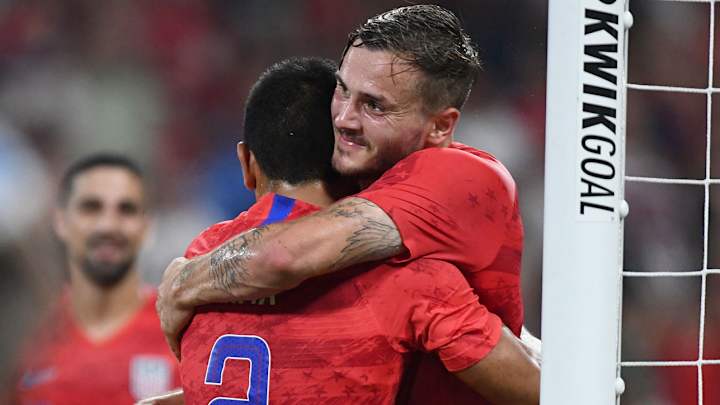Work-In-Progress USMNT Earns a Draw vs. Uruguay

ST. LOUIS — Soccer’s first world champion, Uruguay has a long and illustrious history of being miserable to play against. La Celeste are defensively stout, opportunistic and renowned for their passionate commitment to exploiting every potential advantage.
On Tuesday night, however, Uruguay represented a bit of a reprieve for a U.S. national team that had been stifled four days earlier by Mexico. Yes, the USA managed only a 1-1 draw here at Busch Stadium, extending its winless streak to three games. But after struggling just to cross midfield against Mexico, coach Gregg Berhalter’s makeshift U.S. squad was able to enjoy a bit of sustained and proactive possession—and even create a few good scoring chances—against an opponent that was more willing to sit back and pick its spots.
The result was a friendly that was more even and wide open—one that the U.S. had an opportunity to win. The difference between a draw and victory Tuesday was a couple of plays in the penalty area. Against Mexico, the USA couldn’t even get to the penalty area.
Here are three more thoughts from the draw:
After several good opportunities, an ugly goal draws the USA level
Given the opportunity to begin its buildup at midfield, the U.S. found a bit more comfort on the ball against Uruguay and was able to inflict a little damage. It took only one or two well-placed passes to put the U.S. in behind the visitors’ back four. The first good American chance came in the 11th minute, when Sebastian Lletget’s creative dribbling on the endline led to an on-target header from Cristian Roldan. Tyler Boyd absolutely should’ve scored 11 minutes later, but somehow scuffed Jordan Morris’s cross on the doorstep.
The match opened up even more after a series of substitutes in the second half. But Morris, who started, still had energy. He’d been a factor on the left flank all evening, and in the 79th minute, he saved the USA from suffering a third consecutive defeat by racing to the back post after a determined run through the right channel by Nick Lima. A very lucky bounce–a clearance attempt off Lima's chest that looped back toward goal–fell Morris’s way, and he chested the ball over the goal line from close range.
Someone call the Puskas committee #USAvURU
— SI Soccer (@si_soccer) September 11, 2019
(via @TUDNUSA) pic.twitter.com/I3mbmMeKVR
Uruguay–and LAFC–show strength on the counter
This was a young U.S. team missing Christian Pulisic, among other first-choice players, so its difficulty breaking down Uruguay’s two very tightly packed banks of four was somewhat expected. The wasted chances, especially Boyd’s, were unfortunate. But apart from that, the USA’s biggest issue on Tuesday was defensive transition. From the early moments, Uruguay’s ability to create dangerous counterattacks with quick passing through disorganized, uneven U.S. lines was cause for concern.
It paid off for La Celeste in the 50th minute. Real Madrid youngster Federico Valverde started the play on a run through midfield, and it quickly becomes a three-on-three counterattack. Valverde slipped the ball to his left to Los Angeles FC’s Brian Rodríguez, who had only Aaron Long to beat. And did he ever beat him, cutting inside then back outside with his right foot before sending an unstoppable left-footed blast past goalkeeper Brad Guzan. It was the 19-year-old Rodríguez’s first international goal in only his second appearance.
Brian Rodriguez's powerful finish caps a lethal counter and puts Uruguay in the lead #USAvURU
— SI Soccer (@si_soccer) September 11, 2019
(via @FoxSoccer) pic.twitter.com/56O09o0ODx
Uruguay’s approach gives USA the ball, perhaps some confidence
This was not entirely a Uruguay junior varsity side, even if Luis Suarez, Edinson Cavani, Diego Godin, Nicolas Lodeiro, Cristhian Stuani and Lucas Torreira were among the players not available. Five of Tuesday’s starters also were on the field when La Celeste played France last year in the World Cup quarterfinals. But the stakes in St. Louis were hardly comparable, and Uruguay’s approach was somewhat friendly.
With coach Óscar Tabárez’s midfield tied closely to the back four, there often was room for the U.S. defenders and defensive midfielder Jackson Yueill to play the ball into the space behind Uruguay’s forwards. Roldan and Lletget were often there, or there was time and space to pass wide to Morris or Boyd. As a result, the game took on an entirely different complexion from last Friday’s 3-0 loss to Mexico, when the Americans had difficulty completing the second or third pass and committed critical turnovers in their defensive half. On Tuesday, the match was more frequently on even footing.
It could’ve been faster at times. U.S. decision making was slow, as partnerships and combinations were somewhat new. But there were good moments as well—diagonal balls that forced Uruguay to shift, or runs that created space for teammates. It was better. Now, the stakes will raise with next month’s Concacaf Nations League matches against Canada and Cuba, when Berhalter will have to demonstrate that his players have learned enough to win the games that matter.
